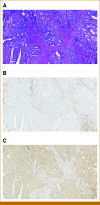Analysis of Concordance Between Next-Generation Sequencing Assessment of Microsatellite Instability and Immunohistochemistry-Mismatch Repair From Solid Tumors
- PMID: 39565978
- PMCID: PMC11594015
- DOI: 10.1200/PO.23.00648
Analysis of Concordance Between Next-Generation Sequencing Assessment of Microsatellite Instability and Immunohistochemistry-Mismatch Repair From Solid Tumors
Abstract
Purpose: The new CAP guideline published in August 2022 recommends using immunohistochemistry (IHC) to test for mismatch repair defects in gastroesophageal (GE), small bowel (SB), or endometrial carcinoma (EC) cancers over next-generation sequencing assessment of microsatellite instability (NGS-MSI) for immune checkpoint inhibitor (ICI) therapy eligibility and states there is a preference to use IHC over NGS-MSI in colorectal carcinoma (CRC).
Methods: We assessed the concordance of NGS-MSI and IHC-MMR from a very large cohort across the spectrum of solid tumors.
Results: Of the over 190,000 samples with both NGS-MSI and IHC-MMR about 1,160 were initially flagged as discordant. Of those samples initially flagged as discordant, 50.9% remained discordant after being reviewed by an additional pathologist. This resulted in a final discordance rate of 0.31% (590/191,767). Among CRC, GE, SB and EC, 55.4% of mismatch repair proficient/MSI high (MMRp/MSI-H) tumors had at least one somatic pathogenic mutation in an MMR gene or POLE. Mismatch repair deficient/microsatellite stable (MMRd/MSS) tumors had a significantly lower rate of high tumor mutational burden than MMRp/MSI-H tumors. Across all solid tumors, MMRd/MSI-H tumors had significantly longer overall survival (OS; hazard ratio [HR], 1.47, P < .001) and post-ICI survival (HR, 1.82, P < .001) as compared with MMRp/MSS tumors. The OS for the MMRd/MSS group was slightly worse compared to the MMRp/MSI-H tumors, but this difference was not statistically significant (HR, 0.73, P = .058), with a similar pattern when looking at post-ICI survival (HR, 0.43, P = .155).
Conclusion: This study demonstrates that NGS-MSI is noninferior to IHC-MMR and can identify MSI-H tumors that IHC-MMR is unable to detect and conversely IHC-MMR can identify MMRd tumors that NGS-MSI misses.
Conflict of interest statement
The following represents disclosure information provided by authors of this manuscript. All relationships are considered compensated unless otherwise noted. Relationships are self-held unless noted. I = Immediate Family Member, Inst = My Institution. Relationships may not relate to the subject matter of this manuscript. For more information about ASCO's conflict of interest policy, please refer to
Open Payments is a public database containing information reported by companies about payments made to US-licensed physicians (
No other potential conflicts of interest were reported.
Figures




Similar articles
-
[Comprehensive assessment of mismatch repair and microsatellite instability status in molecular classification of endometrial carcinoma].Zhonghua Fu Chan Ke Za Zhi. 2023 Oct 25;58(10):755-765. doi: 10.3760/cma.j.cn112141-20230711-00316. Zhonghua Fu Chan Ke Za Zhi. 2023. PMID: 37849256 Chinese.
-
Investigation of discrepant mismatch repair immunohistochemistry and microsatellite instability polymerase chain reaction test results for gynecologic cancers using next-generation sequencing.Hum Pathol. 2022 Jan;119:41-50. doi: 10.1016/j.humpath.2021.10.004. Epub 2021 Oct 16. Hum Pathol. 2022. PMID: 34666078
-
Microsatellite instability and high tumor mutational burden detected by next generation sequencing are concordant with loss of mismatch repair proteins by immunohistochemistry.Cancer Genet. 2025 Jan;290-291:44-50. doi: 10.1016/j.cancergen.2024.12.002. Epub 2024 Dec 15. Cancer Genet. 2025. PMID: 39700818
-
Overview of a comparative analysis of microsatellite instability and standard mismatch repair protein-deficiency tests in a large cancer cohort.Pathologie (Heidelb). 2024 Nov;45(Suppl 1):63-66. doi: 10.1007/s00292-024-01397-4. Epub 2024 Dec 4. Pathologie (Heidelb). 2024. PMID: 39630159 Review. English.
-
A tale of two pathways: Review of immune checkpoint inhibitors in DNA mismatch repair-deficient and microsatellite instability-high endometrial cancers.Cancer. 2024 May 15;130(10):1733-1746. doi: 10.1002/cncr.35267. Epub 2024 Feb 29. Cancer. 2024. PMID: 38422006 Free PMC article. Review.
Cited by
-
Therapeutic targeting of mismatch repair-deficient cancers.Nat Rev Clin Oncol. 2025 Jul 10. doi: 10.1038/s41571-025-01054-6. Online ahead of print. Nat Rev Clin Oncol. 2025. PMID: 40640471 Review.
-
Case Report: Metastatic small bowel adenocarcinoma with DNA mismatch repair deficiency in an organ transplant recipient treated with anti-PD-1 immunotherapy.Front Oncol. 2025 Jun 12;15:1579364. doi: 10.3389/fonc.2025.1579364. eCollection 2025. Front Oncol. 2025. PMID: 40575172 Free PMC article.
-
Deep Gaussian process with uncertainty estimation for microsatellite instability and immunotherapy response prediction from histology.NPJ Digit Med. 2025 May 19;8(1):294. doi: 10.1038/s41746-025-01580-8. NPJ Digit Med. 2025. PMID: 40389599 Free PMC article.
References
-
- Li GM: Mechanisms and functions of DNA mismatch repair. Cell Res 18:85-98, 2008 - PubMed
-
- Reference deleted.
MeSH terms
LinkOut - more resources
Full Text Sources
Medical
Miscellaneous

